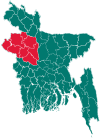Bhangura Upazila
| Bhangura ভাঙ্গুড়া | |
|---|---|
| Upazila | |
 Bhangura Location in Bangladesh | |
| Coordinates: 24°13.5′N 89°24′E / 24.2250°N 89.400°ECoordinates: 24°13.5′N 89°24′E / 24.2250°N 89.400°E | |
| Country |
|
| Division | Rajshahi Division |
| District | Pabna District |
| Area | |
| • Total | 120.2 km2 (46.4 sq mi) |
| Population (1991) | |
| • Total | 81,624 |
| • Density | 680/km2 (1,800/sq mi) |
| Time zone | BST (UTC+6) |
| Website | http://bhangura.pabna.gov.bd/ |
Bhangura (Bengali: ভাঙ্গুড়া) or Bhangoora is an Upazila of Pabna District in the Division of Rajshahi, Bangladesh.[1]
History
Bhangura thana was established in 1980 and was turned into an upazila in 1981. Once Bhangura upazila was a noted jute growing area. For this reason a jute trading company called Chittagong Jute Company established business house on the bank of the river adjacent to the Baral Bridge. Still there exist a house of the extinct company.
Liberation War
During the liberation war several encounters were made between Pakistan Army & Razakars and Mukti Bahini at Baral Bridge and Dilpashar Bridge. A number of Razakars were surrendered. Commandar Hannan, Aslamul led the Mukti Bahini.
Geography
Bhangura is located at 24°13′30″N 89°24′00″E / 24.2250°N 89.4000°E. It has 14,201 households and total area 120.2 km². It is bounded by Tarash upazila on the north, Faridpur (Pabna) upazila on the south, Ullapara upazila on the east, Chatmohar upazila on the west. The upazila is criss-crossed by two rivers named the Baral and the Gumani. The western part of this upazila is relatively higher than the eastern part which comprises a part of the great Chalan Bil. A very large number of small bills are also available in this area. The people here like the simple life.
Demographics
At the 2001 Bangladesh census, Bhangura had a population of 99,474 of which 50,486 were male and 48,988 were female. Average density of population was 731 per square kilometre. It had an average literacy rate of 38.3% (7+ years).
Main Occupations Agriculture but, agricultural labourer, wage labourer, commerce, service, fishing and others also present.
Economy
Total cultivable land 10,460 hectares, fallow land 2,786 hectares; single crop 36%, double crop 40% and treble crop 24%. The market value of the land of the first grade is about 7500 Taka per 0.01 hectare.
Main crops are Paddy, jute, wheat, onion, garlic, green chilly, khesari, musur and patal. Main fruits are Banana, mango, jackfruit, black berry, papaya and litchi. Extinct or nearly extinct crops are barley, chhola, kaun, china and bhura.
Other agriculture activities dairy 312, poultry 60, fishery 2. Bhangura upazila is notable for its milk and milk products. A number of people are involved in production of milk products that include butter, chern, chhana, sweets, etc. These products as well as raw materials are sent to different parts of Bangladesh. Several milk collection and chilling centres of different companies such as Milk Vita, BRAK, Amomilk, Akiz are actively present in this upazila.
Points of interest
Three-domed mosque at Kazipara (Chandipur), Baral Bridge, Boro Bil, Pathorghata four-storied Jame Mosque, Patul Playground.
Administration
Bhangura has one Municipality, 6 Unions, 70 Mauzas, 110 villages and Khana 20576. The unions are Per Bhangura, Bhangura, Dilpashar, Khanmorich, Ashtomonisha ang মন্ডোতোষ নতুন ইউনিয়ন পরিষদ।
Member of the Parliament (MP): Mokbul Hossain (Pabna-3 constitution)
Chairman: Nur Muzahid Shopon
Vice Chairman: Jafor Iqbol Herok
Woman Vice Chairman: মোছাঃ জোসনা খাতুন
Upazila Nirbahi Officer (UNO): মোঃ শামছুল আলম Upazila Engineer ( UE):Md.Sultan Mahmud Bhangura Paurashava Mayor: Md.Golam Hasnain Rasel
Union Parishad Chairmans: Hedhayeatul Haque (Per Bhangura), Mohammad Belal Hossain (Bhangura), বকুল (অষ্টমনিষা) Md. asadur rahman ( খানমরিচ) প্রনো ( দিলপাশার) ও
আব্দুর রশিদ ( মন্ডোতোষ)
Transport
Roads pucca 13 km, semi pucca 4 km and mud road 210 km; waterways 17-nautical-mile (31 km); railways 11 km. Bus and train is the most popular means of transport for communication with other parts of the country. There are three railway stations in this upazila: Baral Bridge, Bhangura and Sharatnagar of them Baral Bridge is the most prominent one where several intercity trains have stoppage, which are: Silk City, Lalmoni, Dhumketu, Sundarban, Chitra etc. Bus services are: Shahzadpur Travels (Bhangura-Dhaka), Syamoli Paribahan (Bhangura-Chittagong), Uttara Paribahan (Bhangura-Rajshahi), B-Nagar (Bhangura-Bogra) and direct bus services also exist from Bhangura to Pabna, Ishurdi, Kushtia, Baghabari (Sirajgonj) etc. Traditional transport Palanquin, dhuli, horse carriage and bullock cart. These means of transport are either extinct or nearly extinct.
Education
Average literacy 26.1%; male 31.7%, female 20.2%. Educational institutions: college 7, collegiate school 0, secondary school 11, madrasa 2, government primary school 47, non-government primary school 00, satellite school 13, community school 3. Noted educational institutes are Bhangura Union High School, Bhangura Jarina Rahim Girls High School, Hazi Jamal Uddin College, Bhangura Girls College, Sharatnagar Fazil Madrasa, Bharamara Udayan Academy, and Kashipur Government Primary School, Patulipara High School, Baral Kindergarten, Shishu Tirtho, Bhangura Biggan School & College, Momotaz Mostafa Ideal School & College,.
Media
- Sachetan
ভাঙ্গুড়া বার্তা. www.bbarta.net
References
- ↑ Md Nuruzzaman Musafir (2012), "Bhangura Upazila", in Sirajul Islam and Ahmed A. Jamal, Banglapedia: National Encyclopedia of Bangladesh (Second ed.), Asiatic Society of Bangladesh
